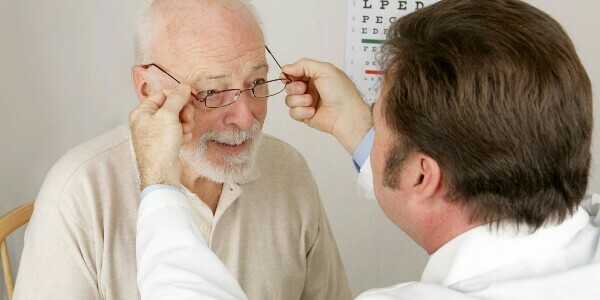
In recent decades, there has been a trend towards an increase in the average life expectancy.
Already, more than 2 billion people on our planet are older than 60 years.
On the one hand, this is a positive phenomenon, and it speaks of an improving quality of life.
But on the other hand, because of the large number of elderly people, doctors of all specialties are faced with the problem of prevention and treatment of various age-related changes in the body.
Ophthalmologists are no exception. Doctors of this profile are more likely to encounter pathologies associated with age. One of such common pathologies is presbyopia. In this article we will consider this ailment in detail.
- 1. What is it?
- 2. Causes of
- 3. Symptoms and Diagnostic Techniques
- 4. Treatment of
- 5. Prevention of
- 6. Forecast of
- 7. Conclusion of
- 8. Video of
What is it?
Presbyopia - a violation of the focusing of eyes on objects that are at close range. The disease is directly related to natural age-related changes.
And sooner or later it occurs in every person who has crossed the sixty-year boundary. Some people begin to notice difficulties in reading and needlework in 40 years.

It is noteworthy that other types of vision are not violated: the patient still sees well at medium and long distances. Often such a violation is called a "short-arm disease".
This name has appeared, because usually for normal focusing the suffering presbyopia has to distance the object at least a distance of arms outstretched.
A brief history of the disease
Accommodation - the ability of the eye to focus on objects located at different distances. This "adjustment" occurs due to the tension of some muscles and temporary changes in the shape of the lens.
Over time, this ability is lost due to the dystrophic changes in the ciliary muscle and the loss of the lens's elasticity. The lens can not take the right shape, and the image is projected incorrectly onto the retina.
After 60 years, the accommodation distance is usually reduced to 1 diopter, and the nearest point at which the eye can easily focus is at least 100 cm apart.
Prevalence and significance
Presbyopia is the most common ophthalmic pathology caused by aging of the body.60% of people over age forty suffer from age-long-sightedness. By the age of 60 this figure is close to 100%.
The most common disease among the population of Western Europe, the United States and Japan. This is due both to the high life expectancy in these countries, and to the large percentage of people involved in skilled work with heavy loads on the organs of vision.
Men and women suffer from presbyopia equally, but the disease manifests in women at an earlier age.
Presbyopia is a socially significant pathology, since in some cases without timely correction it can lead to loss of ability to work due to other visual impairments.

Risk Factors
Despite the fact that presbyopia develops to some extent in all people during life, some groups of individuals are most vulnerable to the development of this disease:
- people aged over 40 years;
- patients with untreated farsightedness and other disorders of accommodation in the anamnesis;
- women;
- are people whose daily activities or work are associated with intense eye strain;
- persons with concomitant systemic pathologies( diabetes, myopathies, iron deficiency, vascular and cardiac dysfunction);
- suffered from infectious diseases in severe form( parotitis, influenza, herpes, measles, meningitis);
- are constantly taking certain medications( antidepressants, antipsychotics, anticonvulsants, diuretics);
- people who underwent various eye interventions( laser microsurgery, vascular photocoagulation) and on the brain;
- inhabitants of hot regions( negative influence of ultraviolet radiation and extremely high temperatures);
- eating defective.
Reasons for

As mentioned above, the main reason for the development of presbyopia is the age-related changes in the lens tissue and a decrease in the mobility of the eye muscles.
With age, the lens thickens and acquires an irregular shape, so that it can not take the necessary curvature.
It is believed that the maximum capacity for accommodation is observed in adolescence and early adolescence, and after that it begins to decline. Only after 2-3 decades of life presbyopia becomes so pronounced that it begins to bring discomfort.
Symptoms and Diagnostic Techniques
Presbyopia has the following manifestations:
- headaches;
- nausea;
- deterioration of color perception;
- a constant sense of tension in the eyes;
- pain in the eyes;
- photophobia;
- complexity of viewing objects at close distances;
- impossibility to read and engage in small handicrafts in the vicinity.
To determine the diagnosis of presbyopia, the physician first collects the patient's anamnesis. He finds out what kind of ophthalmic diseases suffer the respondent. Also its age and presence of accompanying pathologies is important.
No less important are the results of objective diagnostic studies. Most often used:
- skiascopy;
- refractometry;
- definition of accommodation volume;
- ophthalmoscopy;
- biomicroscopy;
- gonioscopy;
- tonometry;
- uzi eyeballs;
- computer and magnetic resonance imaging of the brain.
Do not forget that only a doctor can determine the volume of necessary diagnostic tests. Do not try to do self-diagnosis, as it can confuse you even more.
Often the ophthalmologist recommends receiving advice from other specialized specialists: a therapist and a neurologist.
Treatment
Several methods are used to correct age-related farsightedness.
Medications and other non-invasive methods
Primarily, preference is given to conservative methods of treatment. Patients are prescribed medicines:
- vitamin complexes for the eyes in the form of tablets or drops;
- drops to relieve fatigue;
- moisturizing drops.
Most often, the drug method of treatment does not give sufficient results. In this case, a spectacle or lens correction is used.
This method, when used correctly, is absolutely harmless, but at the same time very effective.
To correct for accommodation disorders, use special lenses( conventional not suitable).There are two types of medical lenses:
- bifocal;
- progressive.
It is important to choose not only glasses or lenses for treatment, but also for everyday wear. Wearing unsuitable glasses and lenses can significantly worsen the course of the disease.
In combination with medical and spectacle correction, physiotherapy methods are used:
- massage;
- laser therapy;
- reflexotherapy;
- electrostimulation;
- training on the device "Brook".
Surgical treatment of

If conservative methods have failed, surgical treatment has to be resorted to. Undoubtedly, it carries certain risks of complications, but at the same time it can save a person from manifestations of presbyopia forever.
The most common options for surgical correction:
- laser microsurgery( Lasik and Superlasik);
- keratectomy;
- intraocular interventions( replacing the natural lens with an implant);
- photoemulsification.
The following video shows how laser vision correction is performed:
Folk methods
Folk methods should always be used with caution after consulting a doctor and should not be used as an independent treatment.
Alternative medicine offers instillation in the eyes of broths of medicinal herbs:
- eyes;
- marigold;
- cornflower;
- plantain.
It is also possible to use as juice drops aloe juice diluted with water.
Prevention
To prevent presbyopia, one should follow simple recommendations:
- observe the regime of work and rest;
- reduce visual load;
- lead a healthy lifestyle;
- Avoid the negative impact of the environment;
- in time treat diseases of the eyes and the whole body as a whole.
To maintain eye health for a long time, do not forget to perform special exercises:
- Charge for vision recovery
- Gymnastics for Avetisov
- Prevention of visual impairment
Forecast
Prognosis for presbyopia is favorable. Usually this disease has a benign course and does not cause serious problems.
Conclusion
- Presbyopia - the loss of the ability to clearly see objects near.
- Presbyopia is an age-related disorder.
- Presbyopia affects the majority of the elderly.
- Both conservative and invasive procedures are used for treatment.
Video
The following video may help you:
